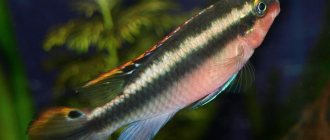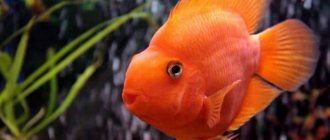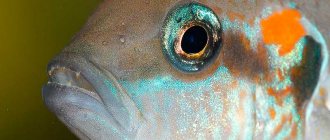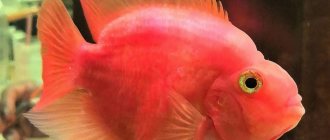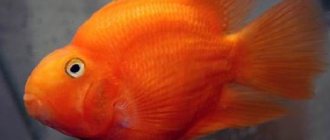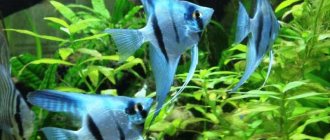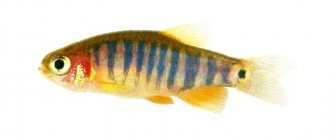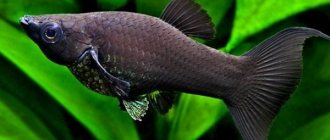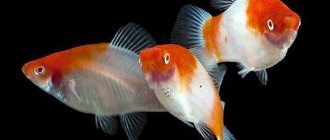by fisher 07/27/2015 0 Comments
Family: Cichlids
African cichlids
Parrotfish, or Pelvicachromis pulcher (Boulenger, 1901), is native to riverine biotopes of West Africa (Benin, Nigeria, Cameroon) and is part of the tribe Chromidotilapini of the subfamily Pseudocrenilabrinae, which includes several relatively numerous genera. Pelvikachromis pulcher , like other species included in the tribe, belongs to dwarf cichlids. In specialized literature, this fish is also mentioned under the names: Pelmatochromis pulcher (Boulenger, 1901), Pelvicachromis sacramontis (Paulo, 1968), Pelmatochromis aurocephalus (Meinken, 1960), Pelmatochromis camerunensis (Paulo, 1968), Pelmatochromis kribensis (non Boulenger, 1911) , Pelmatochromis pulcher kribensis (non Boulenger, 1911). The most common folk names are “Parrot”, “kribensis”. Pelvicachromis pulcher is an old-timer in amateur aquariums, where it has been kept and produced offspring for more than a century.
Pelvicachromis pulcher is perhaps the ideal choice for a beginner aquarist. It is unpretentious to the chemical composition of water, omnivorous, peaceful towards other aquarium fish, including those of a much smaller size, and indifferent to aquarium plants, which cannot be said about most cichlids. In addition, pelvicachromis have bright colors, thanks to which they received their specific name. After all, pulcher is translated from Latin as beautiful, beautiful.
The coloration of adults really attracts the attention of the observer. Two dark longitudinal stripes on a light background of the body, which has a yellowish tint in females and a light cream tint in males.
Males are much larger and slimmer than females, growing up to 7-8 cm in length. The upper part of their diamond-shaped tail is decorated with several black spots edged with gold, and their number can vary from one to seven. The dorsal and anal fins are strongly elongated and pointed at the ends. The dorsal fin has an orange edge, and along its outer edge there are several black spots that often merge into one line. The pelvic fins have a milky lilac tint, and the anal fin and the lower part of the caudal fin are yellowish. Most of the abdomen is colored pink. And only the pectoral fins are transparent.
Pelvicachromis pulcher (male)
Females are more miniature (their length is usually about 4 cm), and the unpaired fins have smoother lines. There are fewer spots on the dorsal fin and tail than on males, and sometimes they are completely absent. The abdomen of females is bright crimson and appears at an earlier age. It is this feature that is decisive when choosing a pair.
Pelvicachromis pulcher (female)
Unfortunately, parrots often go unnoticed by novice aquarists who go to the pet store. This is due to a number of reasons, the main one of which is that, as a rule, young specimens that do not yet have the coloration of adult fish go on sale. In addition, the commercial side of the aquarium hobby forces companies involved in breeding aquarium fish to squeeze everything possible out of producers, often forgetting about the quality of the resulting offspring, as a result of which the color richness of the new generation is often lost. Therefore, difficulties may arise when purchasing quality fish. In addition, currently the popularity of parrots is at a fairly low level, so it is quite rare to find them in pet stores. It is recommended to purchase juveniles measuring 3-4 centimeters. If the volume of the aquarium allows (at least 100 liters), then immediately buy a dozen parrots.
Description
Parrots are bright and unpretentious cichlids. The maximum size of the fish is 10 cm.
Appearance
The fish is called a parrot because of the shape of its head, which resembles a bird's. The body is oblong, compressed at the sides. The fins are pointed. The fish's eyes are large. There are several types and color forms with a beautiful combination of shades.
Behavior
Pelvicachromis pulchera are peaceful and slightly shy fish. Moderately aggressive during spawning, protecting the offspring. They like to rummage in the soil, but do not eat plants.
View this post on Instagram
Pelvicachromis taeniatus "Nigeria Red"
A post shared by Apistogramma_vlz (@apistogramma_vlz) on Aug 22, 2018 at 1:07am PDT
Lifespan
In good conditions they live for about 8 years.
Range and Habitat
Pelvicachromis pulcher (P. pulcher) distribution areas, Africa
Africa: south-eastern Nigeria, as well as Western Cameroon and Eastern Benin.
Pelvikachromis pulcher (P. pulcher) habitats, biotope 1
Pelvikachromis pulcher (P. pulcher) habitats, biotope 2
Habitats in bodies of water with standing or slow-moving water in shallow water. Prefers areas of water bodies overgrown with dense vegetation mixed with open ground. Some populations exist in brackish conditions.
Kinds
- Ordinary. Popular fish include the common parrotfish (Pelvicachromis pulcher). Blue and yellow-brown color forms are common. The main color is gray, the belly is crimson-red. Dark longitudinal stripes run along the body. The ventral fins are red. The tail and dorsal fin of parrots have a yellow edge and several black spots.
- Reticulate. Depending on the gender they are colored differently. Males are golden-gray with scales resembling a net pattern, females are yellow-red. Fins with red splashes. They grow up to 10 cm.
- Yellowbellied. The color of males is beige, there are dark stripes and red edging on the fins. Females are crimson in color with turquoise gills. Maximum length 13 cm.
- Cameroonian. The parrot's back is dirty purple with a dark stripe, and its belly is turquoise. The pelvic fins of males are purple, those of females are red. And also a significant difference between the male Pelvikachromis is the tail with yellow-black spots.
- Variable (striped). There are 5 color forms: males range from olive to yellow, females from blue to purple. The caudal fin is reddish interspersed with blue and purple.
- Golden-headed. Pelvicachromis is small in size (up to 10 cm). The head and body of males are yellow, the dorsal fin is olive with scarlet stripes. Females have a purple abdomen.
- Roloff. The color of male Pelmatochromis parrots is light purple with brown at the back, the fins are brown, the dorsal and tail are decorated with dark spots, and the female Pelmatochromis is gray with a purple tint and orange fins. The tail has dark specks and a white border. Maximum length 9 cm.
Content
The dwarf cichlid is suitable for beginners, because the range of hardness and acidity in which parrots live is quite wide. In its natural environment, water ranges from very soft and acidic to medium-hard alkaline.
Aquarium
For a young pair of Pelvikachromis parrots, a medium-sized aquarium of 70 liters or more is sufficient. To keep a group of pelvicachromis, select a container of 150 liters or more. A lid is required to prevent the fish from jumping out of the water. Parrots also need a large number of shelters:
- grottos;
- coconut shells;
- caves;
- stones;
- pots;
- pipe scraps.
Water parameters
| Water temperature | 24–27 degrees |
| Rigidity | 5–19 dGh |
| Acidity | 5–8 |
| Salted water | No |
| Water movement | average or weak |
Change a quarter of the water and siphon the soil weekly. Check the condition of the water periodically with tests.
Plants
Place floating or plants with strong root systems that do not require much light:
- mosses;
- riccia;
- duckweed;
- blue;
- Java fern.
Priming
Select smooth, fine to medium grade soil, such as fine gravel or sand. The soil should be dark and not pointed, so as not to injure the fish burrowing in the soil. If the substrate is painted, make sure that the paint is harmless to aquarium parrots.
View this post on Instagram
#aquariumonground #biotope #aquarium #jar_on_earth #devijones #ancistrus #catfish #ancitrus #fishtank #plants #apistogram #ramirezi #butterfly #chromisbutterfly #apistogramararamirezi #Ramirezi #Butterfly #cichlid #Pelmatochromis #pulcher #Kribensis #PurpleCichlid #PalletteCichlid #NigerCichlid #cichlidparrot #parrot #kribensis #pelvicachromis
A post shared by @ pashka.splin on Aug 26, 2021 at 10:26am PDT
Equipment
Equipment set:
- filter;
- compressor;
- heater.
Choose a filter that does not create strong water movement. Equip your aquarium with a thermometer. In summer, when temperatures are critically high, cool the water using ice packs. In cold weather, use a heater.
Lighting
Pelvicachromis prefer moderate lighting. The combined use of a lamp and a heater will overheat the water, so be careful and monitor the temperature.
Keeping Pelvicachromis pulchera in an aquarium
Even a small container with a volume of 30 liters (but larger is better) is suitable for keeping one pair.
Pelvicachromis are quite flexible; they can live with equal success in both soft, slightly acidic and harder, slightly alkaline water. Moreover, the water temperature can be in the range from 20 to 30°C; the main condition is that it is transparent and fresh. With an excess of nitrogen compounds, fish become inactive, and color saturation is lost. To prevent this, you should change the water regularly (10-15% of the total volume weekly). The use of a good biological filter is recommended. Parrots prefer not very bright, diffused light.
Male at his property
As for the style of interior design of the aquarium, there is a large field for creativity here. Both bare rocky biotopes and dense thickets of plants are suitable for parrotfish It is recommended to use dark-colored fine gravel as soil. The background can be one color (blue, black) or contain a fragment of a tropical pond in green tones. In such an environment they feel calmer and their colors are brighter. This is also facilitated by the optimal temperature for them (24-26°C), not too hard (dGH 6-18°), slightly acidic or neutral (pH 6.2-7.0) water.
Feeding
Omnivorous parrots consume dry, frozen and live food:
- daphnia;
- gammarus;
- shrimp;
- bloodworm;
- Artemia;
- tubifex;
- Cyclops.
Create a varied diet by combining different types of food. Occasionally add herbal supplements, such as spirulina or a slice of cucumber. Choose high-quality dry food from trusted manufacturers. Do not buy loose feed; check expiration dates. Balanced dry food with herbal supplements will also be useful.
Compatibility
Pelvikachromis have good compatibility with calm and peaceful fish:
- gourami;
- rasborami;
- zebrafish;
- mollies;
- swordtails;
- barbs.
Select neighbors that are suitable in size and parameters of the aquatic environment. Predatory, aggressive and large species are not suitable for living together.
Behavior and Compatibility
Calm, peaceful fish, compatible with other non-aggressive fish of comparable size. Accordingly, you should avoid introducing large, overly energetic, and especially predatory fish. With the onset of the mating season, the behavior of the male changes. He selects an area at the bottom of the aquarium - the site of the future clutch, and begins to protect it from potential rivals. However, this does not pose a great danger to other fish. It is recommended to keep them in a pair or group, where there are several females per male. Moreover, the fish must grow together from a young age. It was noted that newly planted relatives may be attacked. Thus, it is recommended to purchase fish from the same breeder that live in the same aquarium.
Reproduction
Pelvikachromis spawning occurs in a general aquarium or spawning tank. If you are not placing parrots for breeding, take care to delineate the territory and have a large number of shelters. Parents care for and protect the fry even after hatching.
Sex differences
Puberty occurs at the age of 9–12 months. The male's body size is 10 cm, the female's is 7 cm. The male's tail is diamond-shaped, while the female's is rounded. The abdomen of the male is red, while that of the female is more purple and rounded.
Spawning
If several pairs of pelvicachromis live in a tank, then spawning begins with the males fighting for territory. They bump noses and crowd each other out. Having decided on a territory, parrots form pairs and prepare homes for their offspring. Pairs remain for life, so parrots taken from different bodies of water may not produce offspring. It is optimal to house 3-4 fish of different sexes. Stimulate spawning by increasing the temperature by 2-3 degrees and replacing 20% of the water with fresh water. Pelvikachromis spawn in gorges and grottoes. Place several hiding places so that the fish can choose where to lay their eggs. There are 100–300 eggs in a clutch. The fry hatch in 2–4 days.
Fry
The emerging offspring at first cannot swim and lie on the leaves for another 3 days. When the fry move independently, feed them:
- ciliates;
- grated egg yolk;
- living dust;
- Artemia nauplii;
- crushed food for adult fish.
View this post on Instagram
Brood of Pelvicachromis taeniatus "Nigeria Red"
A post shared by Apistogramma_vlz (@apistogramma_vlz) on Oct 24, 2018 at 5:46am PDT
Breeding
Fish form monogamous pairs and the best way to get such a pair is to purchase a group of 6 or more young fish and raise them, allowing them to form pairs naturally. There is no guarantee that purchasing a determined male and female will result in a compatible pair.
Pelvikachromis pulcher (P. pulcher) pair
Pairs are created for life, so it is undesirable to separate the fish.
Pelvikachromis pulcher (P. pulcher) pair, albino form
Capable of spawning in a community aquarium. During this period, their color becomes even brighter. Spawning can be stimulated by regular water changes and increasing the temperature to 28° C. The most suitable shelter for spawning is a clay pot, in which the female lays up to 300 reddish-brown eggs, about 2 mm in size.
Pelvikachromis pulcher (P. pulcher) spawning, caring for offspring
During the incubation period, which lasts up to 4 days, both producers, less often only the female, protect the offspring.
Pelvikachromis pulcher (P. pulcher) caring for offspring, breeding
After about a week, the fry begin to swim independently, now they can begin to be fed with rotifers, artemia nauplii and microworms.
Sometimes, mostly young couples, eat caviar. In this case, the substrate with eggs is placed in a separate container with a sponge filter and intensive aeration.
Pelvikachromis pulcher (P. pulcher) fry, first month of life
During the first month of life, the fry have a dotted pattern, thanks to which they are practically invisible on the bottom, but by 2 months, pronounced horizontal stripes of black color are already visible.
Pelvikachromis pulcher (P. pulcher) fry, 2 months
At approximately 4 months, their colors begin to change and the habits of adults begin to appear.
Pelvikachromis pulcher (P. pulcher) adolescents, 4 months
Diseases
Diseases arise in unfavorable conditions. With proper aquarium maintenance, parrots rarely get sick. They are susceptible to the same ailments as other cichlids:
- Obesity that occurs due to monotonous feeding and overfeeding. In the initial stages it is treated with diet.
- Oodinozu. Accompanied by the appearance of a yellow coating on the parrot's body. Treated with copper sulfate or special medications.
- Ichthyophthyriasis. The parrot's body is covered with white dots, the fish itches against the decorations. There are many drugs against the disease, such as copper sulfate and malachite green.
- Tuberculosis. An infected individual loses color and appetite, and becomes lethargic. In the first stages, treatment with kanamycin is possible.
- Poisoning. If there is an excess of harmful nitrogen compounds in the water, increase aeration and replace a third of the volume of water. To prevent fish poisoning, clean the aquarium promptly and efficiently.
Maintenance and care, arrangement of the aquarium
The optimal size of an aquarium for one pair of fish starts from 60 liters. The design includes a sandy or fine gravel substrate, live or artificial plants, as well as multi-membered shelters. The latter can be not only driftwood, but also various decorative objects, or ordinary ceramic pots turned on their side. They will serve as caves. The plants form dense clumps and are placed in certain areas to leave open areas for swimming. Fish prefer dim lighting, so give preference to shade-loving plant varieties. Successful maintenance depends on maintaining suitable water conditions and regular aquarium maintenance. The hydrochemical composition of water has slightly acidic pH values with low carbonate hardness. Maintaining high water quality will be facilitated by its weekly renewal by 15–20% of the volume, timely removal of organic waste and installation of a productive filtration system. In addition, this will avoid exceeding the concentrations of hazardous substances (products of the nitrogen cycle) in the aquarium.
Photo
Adviсe
- If the tank is located in the bedroom, pay attention to the noise from aquarium equipment. A noisy filter and compressor will be a serious problem.
- In water with a neutral pH level, offspring of different sexes will hatch in equal proportions. In more alkaline water, females predominate; in acidic water, males predominate.
- To prevent algae from appearing, do not allow sunlight to hit the walls of the aquarium. The water tank should be at least 1.5 meters from the windows. The shade of light should not be yellow.
- Always treat live food to avoid introducing parasites into the pond. A solution of potassium permanganate or methylene blue is suitable.
- To avoid stressing your pets, do not turn on the aquarium light right away. First turn on the lights in the room and let the fish get used to the changes. After this, turn on the aquarium lamp.
Pelvicachromis is also interesting because its color changes depending on its mood and well-being. During the spawning period, parrots become especially bright. If parrots are stressed, the colors become less saturated.
Previous
FishEverything we know about fish food
Next
FishSchubert's Barbus fish - not found in nature
